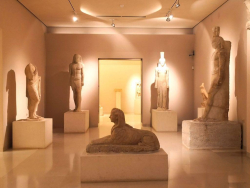Archaeological Museum of Marathon

Archaeological Museum of Marathon
They derive from the excavated sites that are mainly cemeteries of the region. Inside the museum, one can find pottery from the Neolithic Period that was found in the Cave of Pan, from the cemetery of Tsepi early Cycladic pottery and from the cemetery of Vrana Middle Helladic Pottery.
Pottery from Marathon from the Geometric to the Classical periods. One can also see findings from the Tumulus of Marathon. Grave reliefs, as well as statues and dedicatory inscriptions as well as boundary stones from the area of Marathon and, statues and architectural parts from the Egyptian sanctuary at Brexila.
Amongst the most important exhibits of the Museum are the Ionic capital, which is a part of the trophy that was erected after the battle of Marathon, in the memory of the deceased Plataieis. Also, marble stele with inscriptions on both sides.
On the one side, there is a text referring to the reforms of Kleisthenes, the father of the Athenian Democracy and on the other the ordinance for the completing of the Herakleion of Marathon.
There is also a funerary Panathenaic Amphora from the area of Vrana dated in the 4th Century B.C., a statue of a lying deity from the Pytheion area at Oinoe dated in the 2nd Century A.C., an Egyptian-style statue from the gate of the Egyptian sanctuary at Brexila dated in the 2nd Century A.C. and the head of Herodes the Atticus from the Tumulus dated in the 2nd Century B.C.









